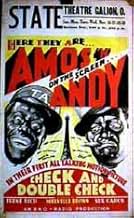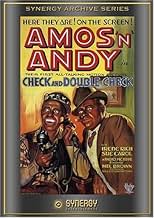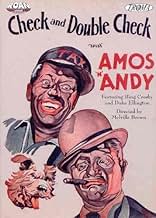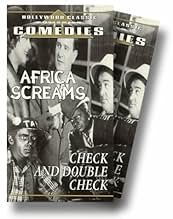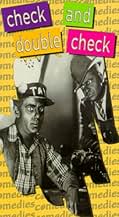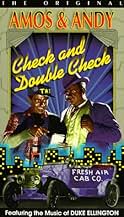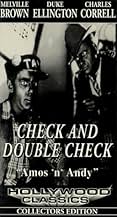Typical Amos 'n Andy storyline has the boys trying to make a go of their "open-air" taxi business while they get caught up in a society hassle, involving driving musicians to a fancy party. ... Read allTypical Amos 'n Andy storyline has the boys trying to make a go of their "open-air" taxi business while they get caught up in a society hassle, involving driving musicians to a fancy party. All the regular characters are here (or mentioned), including the famous Mystic Knights of... Read allTypical Amos 'n Andy storyline has the boys trying to make a go of their "open-air" taxi business while they get caught up in a society hassle, involving driving musicians to a fancy party. All the regular characters are here (or mentioned), including the famous Mystic Knights of the Sea. The only film appearance of radio's long-running characters.
- Director
- Writers
- Stars
- Awards
- 3 wins total
- Richard Williams
- (as Charles S. Morton)
- Elinor Crawford
- (as Rita LaRoy)
- Brother Arthur
- (as Rosco Ates)
- The Cotton Club Orchestra
- (as The Cotton Club Orchestra)
- Akim Tamiroff
- (uncredited)
- Member, Cotton Club Orchestra
- (uncredited)
- Member, Cotton Club Orchestra
- (uncredited)
- Member, Cotton Club Orchestra
- (uncredited)
- Angry Policeman
- (uncredited)
- Policeman
- (uncredited)
- Member, Cotton Club Orchestra
- (uncredited)
- Director
- Writers
- All cast & crew
- Production, box office & more at IMDbPro
Featured reviews
The story opens on a New York City street during a traffic jam where John Blair (Edward Martindel) and his wife (Irene Rich) await patiently in their limousine while on their way to pick up a family friend, Richard Williams (Charles Morton) at Pennsylvania Station. Holding up a line of cars is the run-down Model T cab by owners of the Fresh Air Taxi Company, Amos (Freeman F, Gosden) and Andy Brown (Charles V. Correll). Obtaining a taxi leading to the Blair estate in Hartsdale, New York, Charles meets with the Blair daughter, Joan (Sue Carol), whom he had seen since childhood, horse riding with her suitor, Ralph Crawford (Ralf Harolde). Ralph becomes jealous of their relationship and schemes on keeping them apart. Later, the Blairs hire Duke Ellington and his Cotton Orchestra to perform at their social function, but arrive two hours late due to their slow taxi transport by none other than Amos and Andy. "Check and Double Check" finally serves its title purpose as Amos and Andy attend their lodge club, "The Mystic Knights of the Sea." Their fraternity brother and mystic leader, Kingfish (Russell Powell), selects them as to spend the night in an old abandoned estate in Harlem acting as night watchmen and locate a piece of paper labeled "Check and Double Check," that's to be returned to the lodge the following morning. While the home has a reputation for being haunted, Amos and Andy are unaware the noises are being made by Ralph and assistant searching for an unclaimed deed of Richard's deceased grandfather needed in order for Ricjhard to marry Joan. Roscoe Ates (Roscoe); and Rita LaRoy (Elinor, Ralph's sister) are also seen in the cast. While Amos and Andy's girlfriends, Ruby Taylor and Madame Queen, are discussed, they do not appear.
Anyone familiar with the television series, "The Amos and Andy Show" (1951-1953), would be disappointed by this sole motion picture venture based on the same radio characters. Being an early talkie, certain sequences are drawn-out and stiffly played. Much of the story devotes more time on the Blair family than on Amos and Andy. Although there's no singers, the Blair function does present Duke Ellington's Band playing the hit tune to Bert Kalmar and Harry Ruby's classic, "Three Little Words." Ellington, unfortunately, is glimpsed piano playing either by back of head or side facial profile, only gets his facial view in long shot.
With Hal Roach having Stan Laurel and Oliver Hardy, and RKO Radio having Bert Wheeler and Robert Woolsey, the same studio (RKO) gambled on the success by acquiring another comedy team, Amos and Andy. Reportedly successful in 1930, with viewers getting a full glimpse of the popular dual, interestingly there were no future follow-up Amos and Andy features nor comedy shorts. They did appear on screen once more, doing a guest spot in THE BIG BROADCAST OF 1936 (Paramount, 1935). As it appears, Amos and Andy were probably more popular and funnier on radio than on the silver screen. When Amos and Andy were transferred to television, the two-season comedy series featured natural black actors (Alvin Childress and Spencer Williams) in their title roles, yet they were mostly secondary players to its actual star of that program, Kingfish (wonderfully played by the scene-stealing Tim Moore).
Though Amos and Andy could be said to be black replicas to Laurel and Hardy, with Amos the thin and sensible partner to Amos's fat, loafing, cigar smoking character sitting back to think while Amos does all the work, their comedy routines include mix-up telephone conversation, their new math method with Kingfish; tire changing, and race against time taxi driving to Pennsylvania Station, which unfortunately lacks comedy scoring and obviously staged in front of a rear projection screen.
Who knows if CHECK AND DOUBLE CHECK might have stood the test of time had Amos and Andy been played by actual black actors as Sam McDaniel and Clarence Muse, as opposed to white actors in blackface. Yet with them doing the same exact thing might still stir up controversy by the way how blacks obtain laughter rather than getting laughter.
Having turned up on television around 1979, CHECK AND DOUBLE CHECK, a public domain title, did become available on video cassette (1980s) and years later on DVD. It has turned up sparingly on cable television's Turner Classic Movies, notably in 2006 as part of its subject matter, "Black Images on Film." As in 1930, this comedy would be seen today more as a curiosity than a comedy classic. (**)
Now of course, in "Check and Double Check" Amos and Andy are played by two guys in blackface, the two white guys who have made Amos and Andy famous up until that point. It is very funny seeing the white guys in blackface, because there is no doubting they are indeed white men (Kingfish is white too). Seeing this film was especially interesting for me because I have the two Amos and Andy cartoons from 1934 (the only ones ever made) which use the voices of these two actors.
The movie itself is pretty good, Amos and Andy get mixed up in some society plot, involving some well-to-do white people from Westchester. Back in Harlem, the duo run their taxicab company, and there are some nice shots of New York City in 1930. And for train/subway fans, there is a particular treat, as we go into the original Pennsylvania Station for some shots! There are some funny scenes in the film, with Andy's deadpan lines making me laugh the most. Maybe the thing that would surprise most new viewers of this film, is just how much the actors underplay their roles as Amos and Andy as far as black stereotyping from the 30's goes. As all old film fans know, black actors in these old movies were usually put in for comic relief, making funny faces and noises, looking bug-eyed, running scared at the slightest sound, jumping around with arms flailing if they were scared, etc. But these two guys really don't do any of that. Sure, they play for comedy, but even though they are in blackface, they actually avoid all that kind of stuff, and just play the comedy straight. This may disappoint anyone looking to blast and tear the film apart concerning the two actors as Amos and Andy, but it's the truth, they really don't make an effort to make blacks look silly, they are really playing a comedy while happening to be in blackface.
Most don't understand just how huge the characters of Amos and Andy were in those days. This film is an unbelievable artifact of the era, an entertaining excursion into 1930's comedy. The quality of the print is also downright excellent on the DVD I viewed. I highly recommend this film for entertainment as well as historical study.
But you have to see Check and Doublecheck and realize that it was a pair of white ex-vaudevillians who were playing these characters. And playing them servile. Note right at the beginning of the film as the Fresh Air Taxi was holding up traffic and a cop asks them to move along. Note the tone he takes with them and note the "yassuh" response that both of them give. Later on Amos and Andy are busy reminiscing about the good old days on the plantation back in Georgia before they came to Harlem. Back in Georgia dealing with Klan and lucky to be making enough money to exist on as sharecroppers. Of course you know they're going to help the son of the old plantation owner.
The plot as it is Check and Doublecheck has the son of that former plantation owner previously described looking for the deed to an old abandoned house in Harlem so he can claim title, sell it, and be rich enough to marry his intended. His path crossed that of Amos and Andy who are on a kind of treasure hunt for their Mystic Knights of the Sea Lodge. The intended bride is played by Sue Carol who left acting to become an agent and her most famous client was her fourth and last husband Alan Ladd.
Also in the film are Duke Ellington and his Orchestra. Ellington made his screen debut here and he played himself in several films after this. For that reason this film should be seen, to hear one of the great jazz bands of the last century.
The premise they bring Ellington in is in itself ridiculous. Remember this film is made in 1930 and while Ellington played at Harlem's Cotton Club he didn't get too many bookings at Westchester society parties. But that's what this film would have you believe. That crowd would have more likely hired Leo Reisman or Ray Noble. And of course the band gets there via The Fresh Air Taxi Company.
Singing with the band are The Rhythm Boys, recently detached from Paul Whiteman's Orchestra which included their lead singer Bing Crosby. According to Gary Giddins recent biography of Crosby, Ellington was dissatisfied with the vocal group he had and had RKO hire the Rhythm Boys to sing offstage while three black performers lipsynched. That is one ironic twist of fate. Later on Bing and his partners, Al Rinker and Harry Barris recorded their song from this film Three Little Words with Duke Ellington's orchestra which was a mega hit back in the day.
Even with a hit song coming from this film, Check and Doublecheck created no big demand for Amos and Andy films. Freeman Gosden and Charles Correll stayed on radio for another 25 years with their characters. Maybe just as well they only made one more film appearance in the all star Big Broadcast of 1936.
It involves driving musicians to a fancy party.
All the regular characters are here (or mentioned), including the famous Mystic Knights of the Sea.
The only film appearance of radio's long-running characters.
Guess the movie didn't make much money since there wasn't another. I've only heard bits and pieces of the radio show, but I have the entire TV series on DVD. The TV series is hysterical and anyone who thinks it's somehow racist, is nuts.
This movie, on the other hand is a whole different deal. Amos and Andy are white in black face. It's really odd to watch that these days.
Plus, it's just not a good film.
Did you know
- TriviaBoth actors who played Amos and Andy were white in what was known as "blackface" makeup at the time. Blackface had been mostly abandoned by mainstream American films by 1930, unless it was diegetic (i.e. characters are performers who wear blackface as part of their act). It was decided that all African-American speaking roles in this film would, for aesthetic continuity, be played by white actors in blackface; the only exceptions were Duke Ellington and his orchestra appearing in the party scene, and the occasional non-speaking extra in scenes set in Harlem.
- Quotes
Lodge secretary: At da las' meetin' which was for da purpose of COLLECTIN' DA LODGE DUES, der was NOBODY PRESENT! Dat, gen'lemen, was da minutes of da last meetin'.
- ConnectionsFeatured in Amos 'n' Andy: Anatomy of a Controversy (1983)
- SoundtracksThree Little Words
(1930) (uncredited)
Music by Harry Ruby
Lyrics by Bert Kalmar
Performed by Bing Crosby, Harry Barris and Al Rinker with the Duke Ellington Orchestra
Details
- Runtime1 hour 17 minutes
- Color
Contribute to this page


